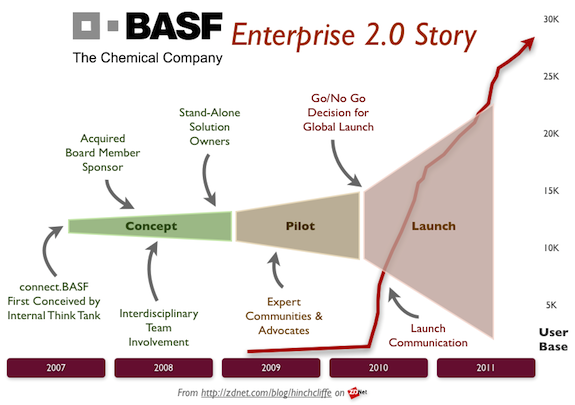Enterprise 2.0 success: BASF

I'm recently back from overseas travel, having provided the closing keynote at the Enterprise 2.0 SUMMIT in Paris last week, for which you can now view the slides. We now pick up the next enterprise social media success story in our ten part series — please read the overview here — which examines recent examples of Enterprise 2.0 in large organizations. The last case study explored what global luxury designer Burberry has started achieving with its end-to-end social business strategy. In today’s case study we look at BASF, the industrial giant that currently operates in over 80 countries. In total, their internal social media strategy, roll-out, and adoption journey spans nearly four years, however they have seen the bulk of the results in only the last year. Here is their story.
BASF is a well-known German company with over 100,000 employees worldwide. A few years ago, when I visited German companies and participated in Enterprise 2.0 events in the country, there was considerable skepticism that collaboration based on social media would ever achieve significant uptake in a conservative business culture that is highly traditional as well as very hierarchical. Fortunately, this turned out not to be the case. These days, it's easy to come across successful examples of European (and German) Enterprise 2.0 initiatives, however BASF has become one of the most well-documented and compelling.
Founded in 1865, BASF is a juggernaut in the chemical industry with over €63 billion in annual revenue and has over 390 production sites across Europe, Asia, Australia, Americas and Africa. One of the hallmarks of modern multinationals is that they tend to have fragmented cultures due to the many time zones and geographic locations they operate in. This is precisely the issue that enterprise social networks can help address, by bringing far-flung workers closer together by creating a unified global culture and a better connected organization.
A recent presentation of their current progress at Lotusphere 2012 by Dr. CheeChin Liew & Cordelia Krooss described the objectives of BASF's Enterprise 2.0 effort: To create a single online business network of employees worldwide to share knowledge, collaborate, and unify the company. By employing social tools strategically, the company hoped to increase worker efficiency and increase the overall value of the work taking place for the company.
The social business platform that was used, based on IBM Connections, included rich user profiles, status updates, communities of interest, searching/tagging capabilities, blogs, forums, bookmarks, file sharing, and important for an industrial company, wikis. The staffing for the effort consists of two global community managers and three regional community managers plus part time involvement of staff for governance and solution stakeholders/owners. There are also numerous advocates who volunteer time to spread awareness and best practices across the company, as well as users that build and help facilitate communities of practice.
The story of the project can be seen in the graphic above, with initial efforts such as planning starting as far back as 2007-2008, when ideation and concept development began. BASF began a pilot in 2009 involving hand-selected expert communities and early advocates, with a full launch in May 2010, accompanied by a well-defined and carefully crafted communication plan. The results speak for themselves: Dubbed, connect.BASF, the platform went from a literal handful of users at the beginning of 2010 to over 15,000 users by the end of that year. Last year saw a continuation of rapid and steady growth, reaching nearly 30,000 users within the company in another year, with the bulk of adoption happening in the last 18 months. Along the way, users of the social business platform created more than 2,300 special purpose communities in which to work.
One of the hallmarks of successful Enterprise 2.0 efforts seems to be the level of advance preparation made to situate it amongst those that will be using it to get work done: The workers on the ground. BASF's effort is notable in the multi-aspect communication plan used to convey connect.BASF's purpose and uses. Formats included Webinars, learning events, demonstrations, and even internal consulting when necessary. Since the use of connect.BASF was voluntary, the effort relied highly on role models in the organization demonstrating how best to use the platform by example.
Lessons Learned
BASF has enumerated the benefits they believe they have received from their internal social business initiative. These include faster and easier access to experts, increases in the value of existing knowledge, higher worker efficiency, better collaboration, reduction in e-mail overhead, and better alignment with younger workers. In addition, BASF has numerous specific examples of useful outcomes using the social tools it has put in place and I urge you to review the deck provided above.
All in all, the lessons practitioners can take aware from the BASF story are numerous and varied. These include the importance of a long-term effort and sustained persistence (it took four years from laying the initial ground work to achieving successful uptake), the value of a detailed and extensive education and communication plan, and the importance of having a community management staff and cultivating advocates. BASF also encouraged emergent outcomes by letting users create communities and by allowing them to self-organize, a key element of Enterprise 2.0 ROI. Finally, having used pilots to validate and tune the approach, BASF launched its social collaboration platforms across the company successfully.
Next Story: Yum! Brands
Don’t miss a single success story. Subscribe to my blog and I’ll keep you updated with the latest case studies.
Other case studies:
- Exploring Enterprise 2.0 Success - Social Business Story #1: Alcatel-Lucent
- Social business success: CEMEX
- Social business success: Burberry
Note: If you'd like to consider adding your organization to this list, represent a Fortune 500 or Global 2000 firm, and have publicly released your data for the first time in approximately the last 24 months, please send me your information via e-mail here.
